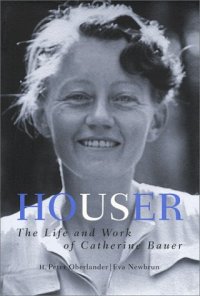
Ebook: Houser: The Life and Work of Catherine Bauer
Author: H. Peter Oberlander Eva Newbrun
- Tags: Drafting & Presentation, Architecture, Arts & Photography, United States, American Revolution, Civil War, US Presidents, Historical, Biographies & Memoirs, Political, Leaders & Notable People, Biographies & Memoirs, Women, Specific Groups, Biographies & Memoirs, Social Services & Welfare, Public Affairs & Policy, Politics & Government, Politics & Social Sciences, Architecture, Humanities, New Used & Rental Textbooks, Specialty Boutique, Public Policy, Political Science, Social Sciences, New Used & Rental Textbooks, Spec
- Year: 2002
- Publisher: University of British Columbia Press
- Language: English
- pdf
Catherine Bauer (1905–64) changed forever the concept of public housing in the United States―and inspired a generation of urban activists to include housing in welfare planning in the mid-20th century. She was one of a small group of idealists who called themselves Housers because of their commitment to raising the quality of urban life through improving shelter for low-income families.
In the late 1920s, Bauer spent time in Paris, where she befriended Ferdinand Leger, Man Ray, and Sylvia Beach, publisher of Ulysses. Back in New York she fell under the spell of urban critic Lewis Mumford. It was at his urging that she became involved with the architects of change in post-World War I Europe, among them Ernst May, Andre Lurcat, and Walter Gropius. Convinced by their example that good social housing could produce good social architecture and moved by the visible ravages of the depression, she became a passionate leader in the fight for housing for
the poor.
Soon established through her critical writings as a housing expert, she lodged the issue of public housing firmly within the New Deal’s agenda and was instrumental in the creation of the first public housing act in 1937. Her book Modern Housing, published in 1934, vividly depicts the essential interdependence of social, economic, and architectural policies in modern life; it is still required college reading. She taught for many years at the University of California Berkeley, as well as Harvard University.
In the late 1920s, Bauer spent time in Paris, where she befriended Ferdinand Leger, Man Ray, and Sylvia Beach, publisher of Ulysses. Back in New York she fell under the spell of urban critic Lewis Mumford. It was at his urging that she became involved with the architects of change in post-World War I Europe, among them Ernst May, Andre Lurcat, and Walter Gropius. Convinced by their example that good social housing could produce good social architecture and moved by the visible ravages of the depression, she became a passionate leader in the fight for housing for
the poor.
Soon established through her critical writings as a housing expert, she lodged the issue of public housing firmly within the New Deal’s agenda and was instrumental in the creation of the first public housing act in 1937. Her book Modern Housing, published in 1934, vividly depicts the essential interdependence of social, economic, and architectural policies in modern life; it is still required college reading. She taught for many years at the University of California Berkeley, as well as Harvard University.
Download the book Houser: The Life and Work of Catherine Bauer for free or read online
Continue reading on any device:

Last viewed books
Related books
{related-news}
Comments (0)